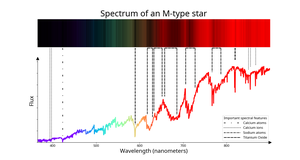Glossary term: M-type Star
Description: A star with spectral type "M". Astronomers identify M-type stars by the presence of molecular absorption bands, primarily from titanium oxide, in their spectra. They have typical (effective) temperatures between around 2500 kelvins (K) and 3700 K. Compared to other stars, they appear red to human eyes. Main sequence stars with spectral type M are known as red dwarfs. M-type stars can also be red giants or red supergiants; these classes are mostly M stars but include some K-type stars as well as some more exotic types of stars with strong spectral features from carbon. Betelgeuse in Orion is an M-type supergiant.
Related Terms:
- Main Sequence
- Molecule
- Red Dwarf
- Red Giant
- Red Supergiant
- Spectral Type
- Spectrum
- Reddening
- Effective Temperature
- Luminosity Class
See this term in other languages
Term and definition status: This term and its definition have been approved by a research astronomer and a teacher
The OAE Multilingual Glossary is a project of the IAU Office of Astronomy for Education (OAE) in collaboration with the IAU Office of Astronomy Outreach (OAO). The terms and definitions were chosen, written and reviewed by a collective effort from the OAE, the OAE Centers and Nodes, the OAE National Astronomy Education Coordinators (NAECs) and other volunteers. You can find a full list of credits here. All glossary terms and their definitions are released under a Creative Commons CC BY-4.0 license and should be credited to "IAU OAE".
Related Diagrams
Spectrum of an M-type star
Credit: IAU OAE/SDSS/Niall Deacon
License: CC-BY-4.0 Creative Commons Attribution 4.0 International (CC BY 4.0) icons









